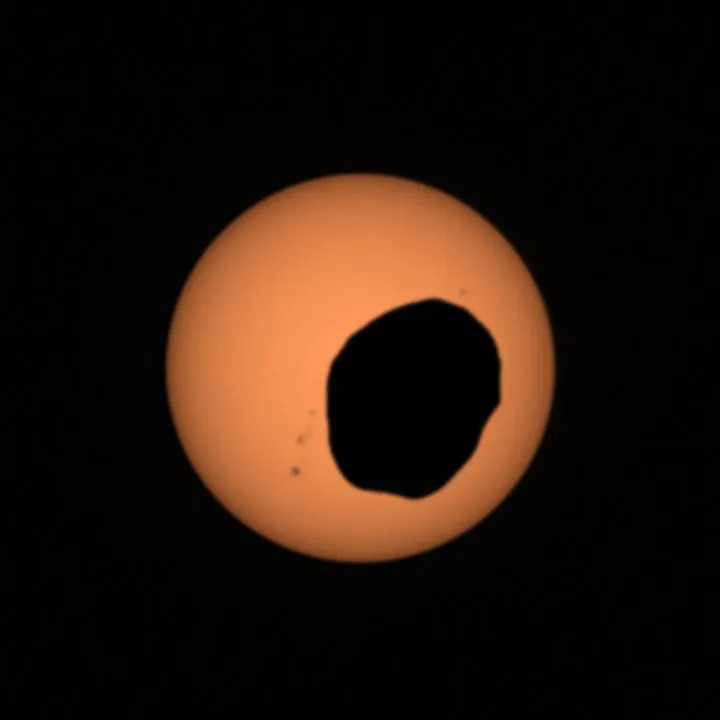Mars has two moons, named Phobos and Deimos, which are named after the sons of Ares, the Greek counterpart of the Roman god, Mars.
Phobos means 'fear' and Deimos means 'dread'.
Mars's moons are very small compared to other moons in the Solar System.

Phobos is 14 miles (22 kilometres) wide, while Deimos is 7.5 miles (12 kilometres) wide, according to NASA.
Phobos orbits 3,700 miles (6,000 kilometres) above the surface of the Red Planet, while Deimos is 12,800 miles (20,500 kilometres) from the Martian surface.
Phobos orbits closer to its host planet than any other known moon and orbits Mars about 3 times every Earth day.
Deimos takes 30 hours for each orbit.

Mars moons discovery
In the early 17th century, Johannes Kepler heard that Galileo had discovered four moons in orbit around the gas giant Jupiter.
This knowledge led him to what can only be described as a fanciful notion: if Jupiter had four moons and Earth one, then Mars, he conjectured, must have two.
It was pure speculation, arguably inspired by the aesthetic neatness of their presumed existence as much as anything else.
But amazingly, and quite coincidentally, he was right.
That Kepler's moons were not quickly discovered in the wake of the Galilean moons was explained by the suggestion they must be both small and close to Mars, making them fearfully tricky to pick out of the blackness of space.

Although no evidence for them could be found, the idea prevailed for a time – the dual moons of Mars would appear both in Jonathan Swift's 1726 novel Gulliver's Travels and in Voltaire's 1750 short story Micromégas.
Mars moons Phobos and Deimos were discovered in August 1877 by American astronomer Asaph Hall.
Hall was conducting a systematic search around the Red Planet using the 26-inch refractor at the US Naval Observatory in Washington DC, found both within the space of a week.
Soon they became known as Phobos and Deimos, after the manifestations of fear and terror in Greek mythology, who also happen to be the sons of Ares, the God of War.
To the Romans, he was known as Mars.

Facts about Phobos and Deimos
It is little wonder that it took so many years and such a large telescope to find Phobos and Deimos.
They are the two smallest moons in the entire Solar System, and are among the least reflective objects in our cosmic neighbourhood.
Phobos is the larger of the two with a diameter of around 22km, meaning its total surface area is less than that of Luxembourg.
It completes a full orbit of the Red Planet in seven hours and 39 minutes.
This is much faster than Mars spins on its axis; any astronaut that NASA manages to place on Mars in the 2030s would see Phobos rise and set roughly twice a day.
From the surface, Phobos would appear to be one-third the width of the full Moon.
Deimos, nearly half as small again with a diameter of 12.4km, would appear star-like in the Martian sky – albeit a star that shines almost as brightly as Venus.
It's a bit more sedate in its orbit, completing a full loop in 30 hours and seven minutes.

Exploration
We would have to wait until later Mariner missions and the Viking probes of the late 1960s and 1970s, each of which returned new images.
They revealed Phobos and Deimos to be irregular, potato-shaped worlds, lacking the gravity necessary to become spherical, and pitted by crater impacts.
Soon we learnt that they were not like our Moon at all, but had more in common with C-type carbonaceous asteroids, the type that dominate our Solar System's asteroid belt.
Perhaps then, the moons of Mars were once asteroids, knocked out of the belt and captured by Mars's gravity.
Though their composition would suggest so, their remarkably circular orbits count against them.
As far we know, if they were truly captured objects they should have elliptical orbits.

The most likely alternative is that Mars's moons formed either from an impact that blew chunks off Mars itself, or coalesced from orbital debris surrounding the Red Planet.
What we can be sure of is that both of these asteroid analogues have uncertain futures.
Deimos's orbit is taking it away from Mars, to the point it will eventually break free of the planet's gravity and zoom away.
Phobos is travelling in the other direction, closing in on Mars at a rate of 2m every 100 years.
Research published in November 2015 suggests that the closer of the two moons is not solid, but a loose coalition of rubble held together by a thin crust, and that in 30-50 million years it will be ripped apart by Mars's gravity – and possibly leave our Solar System with another ringed planet.

Phobos: the first step to Mars?
The road to the Red Planet may yet see humans set foot on the closest of Mars's tiny moons, something we have yet to do even with a lander.
Phobos has been mooted as a potential pit stop as part of a phased approach to a crewed Mars mission, as it would allow NASA to use technology already in development, including the Orion capsule and the Space Launch System.
Not only would this mean astronauts could reach the vicinity of Mars quicker, it would give the space agency a forward operating base from which it could control rovers on the Red Planet until we are ready to send humans in their stead.
